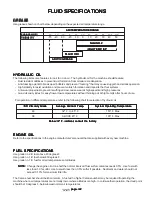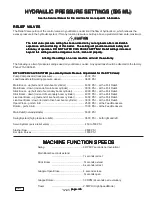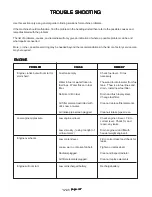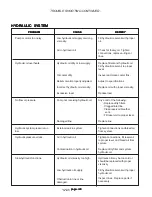
page 33
page 33
page 33
page 33
page 33
595ML CRL
800-00050
LOADING TECHNIQUES AND OPERATIONS
LOADING TECHNIQUES AND OPERATIONS
LOADING TECHNIQUES AND OPERATIONS
LOADING TECHNIQUES AND OPERATIONS
LOADING TECHNIQUES AND OPERATIONS
OPERATING SAFELY
OPERATING SAFELY
OPERATING SAFELY
OPERATING SAFELY
OPERATING SAFELY
- Safety is the operator's responsibility. It is the
operator's responsibility to read the manual
thoroughly, understand the machine's control
functions and all safety precautions and warnings
before operating the machine.
Although you are an experienced operator, don't
assume that controls on this machine are the same
as other similar equipment. Understand and
acknowledge the differences of this machine before
operating.
- Walk around the machine and warn all personnel
who may be near the machine or in the machine
path before starting. Do not start until all personnel
are clearly away from the machine.
- Establish a safe work area:
- where there is plenty of maneuvering room.
- where ground is smooth, even and firm.
- where there are no obstacles.
- Know the perimeters of the established work
area.
- Do not establish the work area:
-
near edges of a ditch.
-
in slide areas.
-
near river or stream banks.
-
near overhangs or excavation sites.
- Always wear the seat belt, if provided.
- Always remain in the operator's seat while machine
is energized and/or while boom is lifted.
- Start and operate the machine only from the
operator's station.
- Move controls slowly to get the feel of the
machine.
- Hydraulically operated controls (joysticks)
become inert when engine is shut down
and hydraulic power is lost, unlike directly
connected mechanical levers (used on some
machines) that can cause movement of
components even after engine is shut down.
OPERATING PROCEDURES
OPERATING PROCEDURES
OPERATING PROCEDURES
OPERATING PROCEDURES
OPERATING PROCEDURES
This machine is built to lift loads and is extremely
powerful. Do not operate carelessly. There is potential
for personal injury and equipment damage. Be
concerned about safety when preparing to operate
machine. Operator must handle load so that
maximum stability is maintained. Be familiar with size
and weight of handled materials.
Ensure safe operation by inspecting machine as stated
in Start-up Procedures
Start-up Procedures
Start-up Procedures
Start-up Procedures
Start-up Procedures under
Pre-Maintenance Check List. This inspection amounts
to a common sense visual check of machine at
beginning of every operation. Follow a preventive
maintenance program; such a procedure will reduce
possibility of costly down time. Read Start-up
Start-up
Start-up
Start-up
Start-up
Procedures
Procedures
Procedures
Procedures
Procedures of this manual and understand them before
operating machine.
Always allow engine and hydraulic system to warm up
before operating. See Start-Up Procedures
Start-Up Procedures
Start-Up Procedures
Start-Up Procedures
Start-Up Procedures. Run
engine at idle for about five minutes. Then operate
hydraulic controls several times: lift and lower booms,
open and close grapple, and swing machine in both
directions. During colder temperatures increase warm-
up time.
Take advantage of easy operation of machine. Keep
operating distance as short as possible. Keep work
area small to shorten cycle time.
Plan ahead to place machine, stock pile, and loading
area in position for as short a cycle as possible to
increase production.
GETTING THE FEEL OF THE
GETTING THE FEEL OF THE
GETTING THE FEEL OF THE
GETTING THE FEEL OF THE
GETTING THE FEEL OF THE
LOADER
LOADER
LOADER
LOADER
LOADER
Before starting the first job with a new machine, it is
suggested that the now trained operator find a good
open spot on firm, level ground that is free of
obstructions such as trees, buildings, other
equipment, and people. Move machine to this cleared
area and spend some time just getting to know the
"operating feel" of the machine. Every machine has a
slightly different feel and individual response to
movement of controls. This "get
acquainted" time will allow operator to become familiar
with controls before beginning work.
The fluid nature of hydraulic power requires a special
operating approach to the hydraulic loader that can be
described as a smooth, even technique. Control levers
should be moved in a gradual, deliberate way rather
than with jerky, abrupt movements. Jerky operation
can cause damage and early wear to loader and will
overheat hydraulic system.




































